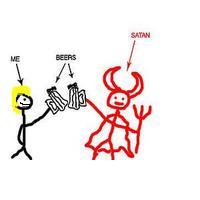I've already written about Plasmodium's origins as a protozoan. It started in Africa (of course) and went through several mutations. It evolved from Plasmodium to P. malariae. It wasn't very efficient because it took so long to do its development inside of the Anopheles (on the plus side, it could lie dormant inside a human body for decades as well just waiting for the right mosquito to bite.)
P. malariae is still around by the way and is referred to as the "benign malaria" or "quartan malaria." Shah refers to quartan fever through the book but never explains what it means. That means the fevers occur at 3-day intervals as opposed to tertian fever, which is the 2-day interval caused by other forms of Plasmodium.
It eventually mutated into a more successful form, P. vivax, that is also still around today. That version could make the round trip from sporozoite to gametocyte in the victim's body within 3 days so it would be ready to spread as soon as 3 days after the victim was bitten. P. vivax was foiled for a while by a human genetic mutation now known as Duffy cells-they are the absence of proteins on the red blood cell's surface which means the parasite can't grab hold. Don't get too excited though because this mutation isn't universally available-Caucasians and Asians generally don't have it. This mutation makes no functional difference to the humans who have it, unlike a later mutation. Which brings me to...
The parasite mutated again into P. falciparum (pronounced fal-SIP-ar-um) which could bypass the Duffy cell mutation and was much more successful at its hemoglobin munching and immune cell evasion. The sickle cell mutation is in response to this form of Plasmodium.
Quinine was known as an antidote for centuries and was guarded as a secret by the Spanish (and that now explains why they were more successful than that ill-fated Scottish colony at Darien in Panama.) It comes from the bark of the cinchona tree which is indigenous to the Andes. Kind of curious that the cure for an African protozoan would be found in South America. How old is this thing? Does it date back to when these continents were attached?
(Holy shit. I just found the most amazing site with a map of the Pangea breakup. If somehow the tree and the parasite are related, that would mean it's as old as the Jurassic period at least, so ~ 130 million years.)
So, quinine. It did start to catch on but various attempts to transplant it and cultivate it elsewhere were met with Spanish resistance and difficulties in cultivation. The Dutch finally got a quinine-rich variety growing in their colony on Java after much trial and error. The problem was they cornered the market and were charging ridiculous prices. The US tried to sue them for antitrust violations in the 1930's but the Dutch Kina Bureau didn't give a shit. What finally broke their monopoly was WWII. The Germans seizes the Netherlands while the Japanese seized Java. This led to the invention of chloroquine (and the less successful quinacrine which apparently turns your skin yellow and can cause psychosis. It is still being used in some cases so try not to catch Creutzfeldt-Jacob disease or eat poo, like my roommate did in Syria.)
Some famous people who died of malaria include Alexander the Great (probably), Genghis Khan (ditto), Lord Byron and 4 popes within 100 years in the Middle Ages. Oliver Cromwell died of it in 1652 although the quinine remedy was known-due to the remedy being advocated by Jesuits, he thought it was some kind of Catholic plot and died which is some beautiful karma at work. Oddly enough, his successor Charles II died of malaria too in 1685 (wikipedia says kidney failure but Shah's book is footnoted.) Charles actually did take the cinchona bark remedy but it wasn't until 1820 that two French chemists (Pelletier and Caventou) isolated the compound and figured out how to extract it. Depending on the age or species of cinchona bark you select to munch upon, you might get a mouth full of splinters and no quinine.
There was a statue in France commemorating Pelletier and Caventou's achievement but the asshole Nazis melted it down to make munitions during the War.

No comments:
Post a Comment